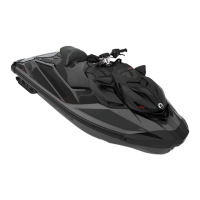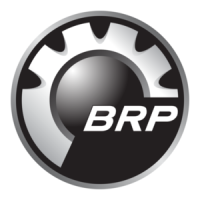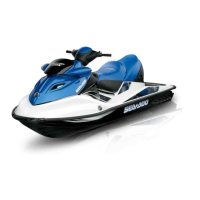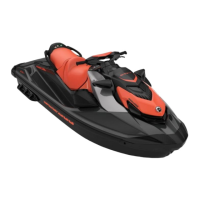
Do you have a question about the BRP Sea-Doo GTX 2022 Series and is the answer not in the manual?
| Displacement | 1630 cc |
|---|---|
| Engine Type | Rotax 1630 ACE |
| Rider Capacity | 3 |
| Weight | 385 kg (849 lbs) |
| Brake System | iBR® (Intelligent Brake & Reverse) |
| Reverse System | iBR® (Intelligent Brake & Reverse) |
| Horsepower | 170 HP |
Crucial information and precautions to review before operating the watercraft.
Requirements and considerations for operator age, ability, and qualifications.
Emphasizes the dangers of operating under the influence of substances.
Details essential protective equipment required for all riders.
Discusses the pros and cons of wearing helmets for safety.
Lists mandatory safety equipment that must be carried aboard the watercraft.
Introduces the user to the watercraft's controls, features, and handling.
Explains the function and proper use of the engine cut-off tether cord.
Describes the operation and features of the iBR braking system.
Provides guidelines for safely carrying cargo and using storage compartments.
Advises on the safe installation of accessories and the risks of modifications.
Covers essential practices for safe and responsible watercraft operation.
Strategies and awareness for preventing collisions on the water.
Discusses the risks associated with high-speed operation and skill requirements.
Explains how to safely reboard the watercraft from the water.
Warns about hazards associated with moving parts of the watercraft.
Emphasizes understanding water conditions, weather, and navigation.
Covers general rules for safe navigation and avoiding collisions.
Details the dangers of carbon monoxide and prevention methods.
Safety precautions related to gasoline and fire prevention.
Guidelines for towing skiers, wakeboarders, or tubers safely.
Safety precautions related to the use and handling of tow ropes.
Provides detailed instructions for safe fuel handling and filling procedures.
Details recommended fuel types and octane ratings.
Guidelines and safety precautions for trailering the watercraft.
Information about critical safety labels affixed to the watercraft.
Details the information presented on the general warning label.
Highlights critical safety information related to fueling the watercraft.
Information specific to high-performance models.
Safety information related to the watercraft's battery.
Instructions and notices for using the glove box.
Warning and instructions related to the watercraft tipping over.
Warning about moving parts of the iBR system.
Notice emphasizing the importance of flushing the exhaust system.
Pictogram indicating where not to sit.
Warning about hot coolant and not opening the system when hot.
Safety instructions related to the wakeboard support.
Instructions on the proper use of the retractable ski post.
Safety guidelines for spotters and weight limits for the ski post.
Warning about incorrect fuel placement and fire hazards.
Information about hang tags for high-performance models.
Warning regarding chemicals exposure in California.
Instructions and information about the iBR system hang tag.
Overview of compliance labels and their locations.
Canadian compliance notice with safe limits and manufacturer details.
Information about engine manufacturer identification.
Information on emission standards applicable across regions.
Information about the star label hang tag for cleaner engines.
Pre-launch checks to ensure the watercraft is safe and ready for operation.
Inspection of the hull, ride plate, and water intake grate for damage.
Instructions for inspecting and cleaning the jet pump water intake.
Ensures bilge drain plugs are properly secured before launching.
Instructions for filling the fuel tank safely.
Inspecting the engine compartment for fuel vapor odor.
Checking engine oil level and ensuring it's within specifications.
Verifying engine coolant level and checking for leaks.
Checking steering operation for free movement and proper nozzle alignment.
Checking the electronic throttle control lever for smooth operation.
Checking the iBR lever for free and smooth operation.
Ensuring all compartments, platform, and seat are closed and latched.
Ensuring the wakeboard rack is secure and the wakeboard is properly positioned.
Verifying the ski/wakeboard pylon is extended, locked, and used correctly.
Testing the engine start/stop button and tether cord function.
Checks to perform after launching and before riding.
Testing the proper operation of the iBR system.
Testing the variable trim system for proper adjustment and function.
Overview of the watercraft's control system and components.
How the handlebar controls direction and the importance of throttle for steering.
Operation of the throttle lever for engine speed control.
Controls on the right handlebar for navigating the multifunction gauge.
Button for accessing BRP Connect features.
Function and safety of the engine cut-off switch and tether cord.
Explanation of the D.E.S.S. key system for engine starting.
Controls on the left handlebar for various functions.
How to select between Normal, Sport, or Eco modes.
Activating the iDF system to clear debris.
Procedures for starting and stopping the engine and electrical system management.
Operation of the iBR lever for brake, reverse, and neutral functions.
Overview of the watercraft's various equipment and components.
Description and operation of the glove box for personal articles.
Details about the watertight compartment for phones and USB charging.
Information about the front storage compartment for larger items.
Location and use of the fire extinguisher support.
Location and use of the safety kit support.
Description of the ergonomic seat design and its benefits.
Details on removing and installing the seat.
Importance of keeping feet on footwells while riding.
Usage and limitations of mooring cleats.
Features and operation of the BRP Audio Premium System.
Controls for audio system functions, volume, and Bluetooth.
Instructions and safety warnings for using the boarding ladder.
Usage and limitations of front and rear eyelets for mooring and towing.
Instructions for unscrewing bilge drain plugs for drainage.
Location and purpose of passenger handholds.
Instructions for extending and retracting the ski pylon.
Steps for removing and installing the ski pylon.
Instructions for installing and using the wakeboard rack.
Safety warnings for a properly secured wakeboard.
Instructions for removing the wakeboard rack.
How to adjust the handlebar position for rider preference.
Ensuring the steering column latch is properly engaged.
Information about the 7.6-inch digital display and its functions.
Overview of the display's basic functions and layouts.
Explanation of warning and telltale lights on the display.
Explains various icons and indicators shown on the display.
Menu options for adjusting settings like clock, Bluetooth, and display.
Navigating through different menu options.
Accessing trip data, fuel consumption, and speed statistics.
Buttons for selecting and adjusting operating modes.
How to switch between Normal, Sport, and ECO drive modes.
Information about vehicle condition messages and indicator lamps.
Information about the large LCD display and its features.
Overview of the large LCD display's functions and layout.
Explanation of warning and telltale lights on the large LCD display.
How to navigate through menus and select functions on the display.
Menu options for adjusting settings on the large display.
Controls for navigating settings and menus.
Controls for audio system functions, volume, and Bluetooth.
Settings for audio configuration like volume control and equalizer.
Steps to program and set up the Ski Mode for towing.
Process for pairing a smartphone with the watercraft via Bluetooth.
Instructions for setting up and using the BRP Connect app.
How to access and launch apps through the system.
A brief overview of the BRP Connect app's features and navigation.
Information about vehicle condition messages and indicator lamps.
Guidelines for operating the watercraft during its break-in period.
Procedures for safely boarding the watercraft.
Instructions for boarding the watercraft from a dock.
Safety advice for boarding in shallow water.
Safety precautions for boarding the watercraft in deep water.
Steps for boarding the watercraft alone without a ladder.
Instructions for boarding with a passenger present.
Step-by-step guide for starting the watercraft engine safely.
Procedures for safely stopping the watercraft engine.
How to steer the watercraft and the role of throttle.
How to engage the neutral position and adjust it.
Adjusting the neutral position of the iBR system.
Engaging forward thrust from neutral or reverse.
Engaging and using the reverse function of the watercraft.
Engaging and using the iBR braking system.
How to use the VTS for adjusting watercraft attitude and performance.
Using VTS buttons to adjust trim positions for optimal performance.
Activating and deactivating the launch control system for optimal acceleration.
General advice for safe and efficient watercraft operation.
How to safely cross wakes and waves.
Techniques for stopping and docking the watercraft.
Procedures and precautions for beaching the watercraft.
Step-by-step guide to using the iDF system for debris removal.
Information on different operating modes like Touring, Sport, ECO, and Speed Control.
Description of the default riding mode for comfortable cruising.
How to activate and use Sport Mode for enhanced performance.
Description of ECO Mode for fuel efficiency.
Explanation of available speed control modes like limiter and slow speed.
How to set and use the speed limiter for controlled riding.
Using Slow Speed Mode for low-speed control and obstacle avoidance.
How to use Ski Mode for towing skiers or wakeboarders.
Explanation of the RAMP function for controlled launches.
How the TARGET SPEED function limits towing speed.
Procedures for specific situations like cleaning, capsizing, or submersion.
Procedures for cleaning the jet pump intake and impeller.
How to use the iBR override function for manual gate movement.
Instructions for righting a capsized watercraft and engine safety.
Procedures to minimize engine damage after submersion.
Warnings and procedures for a water-flooded engine.
Precautions for towing the watercraft in water.
Scheduled maintenance tasks based on time or operating hours.
Detailed instructions for performing basic maintenance tasks.
Recommended engine oil types and specifications.
Instructions for checking and maintaining the engine oil level.
Procedures for changing engine oil and replacing the oil filter.
Information on recommended engine coolant and its properties.
How to check and maintain the engine coolant level.
Access, removal, and installation of ignition coils.
Procedures for removing and installing spark plugs.
Steps for installing spark plugs correctly.
Importance and procedure for flushing the exhaust system.
Inspection of ride plate and water intake grate for damage.
Inspection of sacrificial anodes on the pump and ride plate.
How to inspect fuses and replace them if burnt.
Location of the fuse box within the watercraft.
Table detailing fuse ratings and their corresponding functions.
Guidelines for cleaning and caring for the watercraft.
Steps for care after operating the watercraft.
Extra care needed for operations in foul or salt water.
How to clean the watercraft seat.
Repair and cleaning of the body and hull.
Applying wax and covering the watercraft for protection.
Procedures for storing and preparing the watercraft for the season.
General guidelines and recommendations for storing the watercraft.
Maintenance and cleaning of the propulsion system for storage.
Procedure for draining the exhaust system to prevent freezing.
Lubricating engine cylinders for storage.
Testing antifreeze density for storage in cold climates.
Information about battery removal and charging.
Cleaning the engine compartment and performing anticorrosion treatment.
Tasks to perform for preseason maintenance.
How to identify the watercraft using Hull and Engine Identification Numbers.
Regulatory information about the RF D.E.S.S. key system.
Regulatory compliance information for the multifunction gauge.
Technical specifications related to the multifunction gauge.
FCC and Industry Canada compliance information.
Mexican compliance information.
Brazilian compliance information.
Japanese regulatory compliance information.
European Declaration of Conformity information.
Technical details and regulatory compliance for the audio system.
Information regarding engine emissions and related regulations.
Manufacturer's obligations regarding engine emission certification.
Owner's duty to maintain engine for emission compliance.
EPA regulations for controlling air pollution from watercraft engines.
Information on the evaporative emission control system for California models.
European Community Declaration of Conformity.
Detailed technical specifications for the watercraft.
Detailed specifications for Rotax ACE engines.
Information on engine oil type, capacity, and recommendations.
Specifications for the watercraft's cooling system.
Details on fuel injection, type, octane, and tank capacity.
Specifications for ignition system, battery, and spark plugs.
Details on jet pump type and drive shaft coupling.
Information on the VTS system control.
Specifications for dry weight, load limits, and storage capacity.
Overall length and width dimensions of the watercraft.
Material specifications for impeller and housing.
Guide to diagnosing and resolving common operational issues.
Troubleshooting steps for when the engine fails to start.
Troubleshooting steps when the engine cranks slowly.
Steps for diagnosing issues when the engine turns but won't start.
Troubleshooting steps for engine misfires and irregular running.
Causes and solutions for engine smoke issues.
Troubleshooting steps for engine overheating problems.
Diagnosing and resolving issues with lack of engine acceleration or power.
Troubleshooting steps for when the watercraft cannot reach its top speed.
Resolving issues with the iBR lever keeping the watercraft in neutral.
Troubleshooting when the iBR indicator light is on and the lever doesn't return to neutral.
Troubleshooting when the iBR indicator light is off and the lever doesn't return to neutral.
Identifying and resolving abnormal noises from the propulsion system.
Troubleshooting steps for water found in the bilge.
Information on the system's monitoring capabilities and fault detection.
Understanding and displaying fault codes for system diagnostics.
Information on indicator lights and messages displayed on the information center.
Explains beeper codes and their corresponding meanings.
Warranty terms and conditions for Sea-Doo personal watercraft in USA and Canada.
Defines the scope and terms of the limited warranty for USA and Canada.
Outlines limitations on liability and disclaimers for the warranty.
Lists items and conditions not covered by the warranty.
Specifies the duration of the warranty coverage for different uses.
Lists the conditions that must be met for warranty coverage.
Steps for the customer to obtain warranty service.
Explains BRP's obligations for warranty repairs or replacements.
Conditions for transferring the limited warranty to a new owner.
How to get assistance if warranty issues are unresolved.
Warranty information related to US EPA emission standards.
Duration of the warranty for emission-related components.
Lists components covered under the emission-related warranty.
Conditions under which warranty claims may be denied.
Warranty statement for California's evaporative emissions control system.
Explains the owner's rights and responsibilities regarding emissions warranty.
Details the manufacturer's warranty coverage for the emissions system.
Lists specific parts covered under the evaporative emissions warranty.
Owner's responsibilities for maintaining the watercraft for warranty purposes.
Warranty statement for California and New York emission control systems.
Details warranty coverage for emission control parts.
Lists specific emission control parts covered by the warranty.
Owner's responsibilities for required maintenance and warranty claims.
Explanation of the star rating system for cleaner marine engines.
Warranty terms and conditions for international markets.
Defines the scope of the international limited warranty.
Outlines limitations and disclaimers for the international warranty.
Lists items not covered by the international limited warranty.
Specifies the warranty coverage period for international markets.
Conditions for obtaining warranty coverage in international markets.
Steps for customers to obtain warranty service internationally.
BRP's obligations regarding repairs and replacements under warranty.
Conditions for transferring the international warranty to a new owner.
How to get consumer assistance for warranty issues.
Warranty terms for EEA, CIS, and Turkey markets.
Defines the scope of the warranty for EEA, CIS, and Turkey.
Outlines limitations and disclaimers for this warranty.
Lists items not covered by this warranty.
Specifies the warranty coverage period for these regions.
Conditions required for warranty coverage in these regions.
Steps for obtaining warranty service in these regions.
BRP's obligations for warranty repairs and replacements.
Conditions for transferring the warranty to a new owner in these regions.
How to get consumer assistance for warranty issues.
Section for recording pre-delivery service details.
Section for recording details of the first inspection.
Section for recording service history.
Information regarding the use of customer data and privacy policies.
Contact information for various regions and BRP support.
Procedures for updating address or ownership information.
Instructions on what to do if the boat is stolen.












